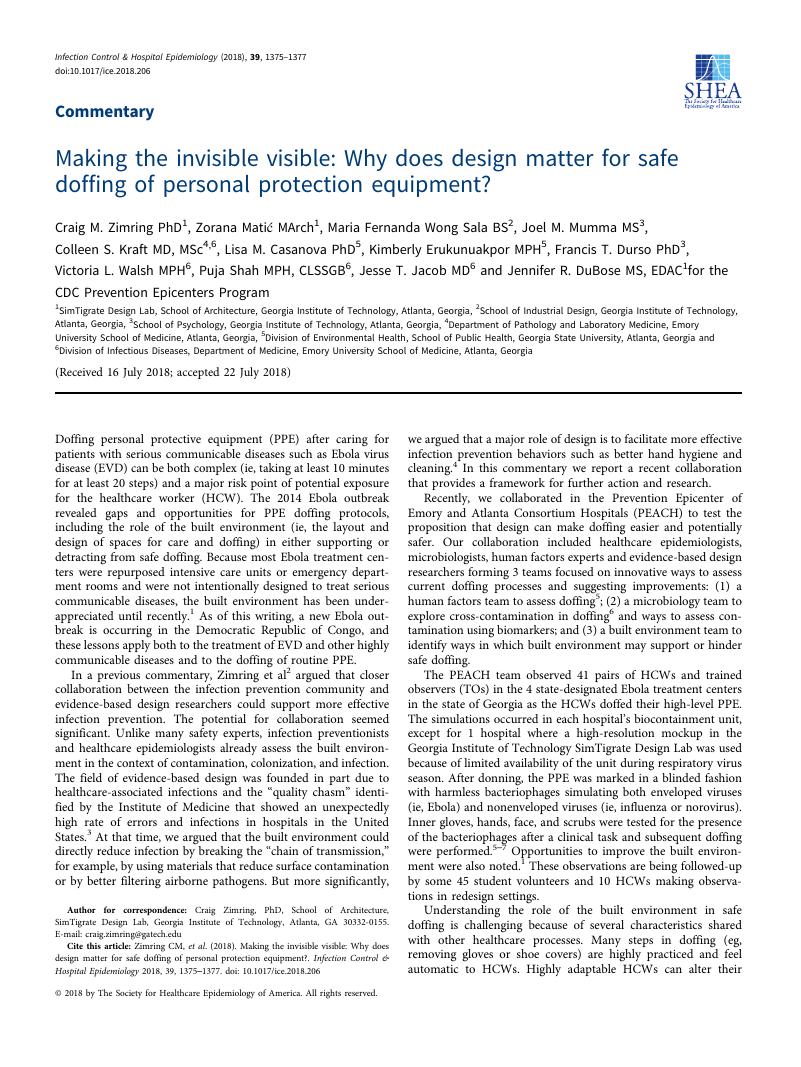Crossref Citations
This article has been cited by the following publications. This list is generated based on data provided by Crossref.
Bleasdale, Susan C.
Sikka, Monica K.
Moritz, Donna C.
Fritzen-Pedicini, Charissa
Stiehl, Emily
Brosseau, Lisa M.
and
Jones, Rachael M.
2019.
Experience of Chicagoland acute care hospitals in preparing for Ebola virus disease, 2014–2015.
Journal of Occupational and Environmental Hygiene,
Vol. 16,
Issue. 8,
p.
582.
Andonian, Jennifer
Kazi, Sadaf
Therkorn, Jennifer
Benishek, Lauren
Billman, Carrie
Schiffhauer, Margaret
Nowakowski, Elaine
Osei, Patience
Gurses, Ayse P
Hsu, Yea-Jen
Drewry, David
Forsyth, Ellen R
Vignesh, Arjun
Oresanwo, Ifeoluwa
Garibaldi, Brian T
Rainwater-Lovett, Kaitlin
Trexler, Polly
and
Maragakis, Lisa L
2019.
Effect of an Intervention Package and Teamwork Training to Prevent Healthcare Personnel Self-contamination During Personal Protective Equipment Doffing.
Clinical Infectious Diseases,
Vol. 69,
Issue. Supplement_3,
p.
S248.
Wong, Maria F
Matić, Zorana
Campiglia, Gabrielle C
Zimring, Craig M
Mumma, Joel M
Kraft, Colleen S
Casanova, Lisa M
Durso, Francis T
Walsh, Victoria L
Shah, Puja Y
Shane, Andi L
Jacob, Jesse T
and
Dubose, Jennifer R
2019.
Design Strategies for Biocontainment Units to Reduce Risk During Doffing of High-level Personal Protective Equipment.
Clinical Infectious Diseases,
Vol. 69,
Issue. Supplement_3,
p.
S241.
Guasch, E.
Brogly, N.
and
Manrique, S.
2020.
Practical recommendations in the obstetrical patient with a COVID-19 infection.
Revista Española de Anestesiología y Reanimación (English Edition),
Vol. 67,
Issue. 8,
p.
438.
GÜNEL, Bedirhan
ŞAHİN, Fatih
and
TAŞ TUNA, Ayça
2020.
Covid-19 Pozitif Gebede Acil Sezaryen Anestezisi Yönetimi: Olgu Sunumu.
Sakarya Medical Journal,
Wundavalli, LaxmiTej
Singh, Sheetal
Singh, Angel Rajan
and
Satpathy, Sidhartha
2020.
How to rapidly design and operationalise PPE donning and doffing areas for a COVID-19 care facility: quality improvement initiative.
BMJ Open Quality,
Vol. 9,
Issue. 3,
p.
e001022.
DOLINGER, MICHAEL
and
MARSH, ASHLEY
2020.
Architecture Can Heal: Spatial Literacy to Protect COVID‐19 Healthcare Workers.
Ethnographic Praxis in Industry Conference Proceedings,
Vol. 2020,
Issue. 1,
p.
324.
Cai, Hui
Zilm, Frank
Sheward, Hugo
and
Graham, Kerianne
2020.
Responding to COVID-19: Healthcare Surge Capacity Design for High-Consequence Infectious Disease.
Technology|Architecture + Design,
Vol. 4,
Issue. 2,
p.
135.
Bampoe, S.
Odor, P.M.
and
Lucas, D.N.
2020.
Novel coronavirus SARS-CoV-2 and COVID-19. Practice recommendations for obstetric anaesthesia: what we have learned thus far.
International Journal of Obstetric Anesthesia,
Vol. 43,
Issue. ,
p.
1.
Billman, Carrie L.
Flinn, Jade
Gadala, Avinash
Bowman, Chad
McIlquham, Taylor
Sulmonte, Christopher J.
and
Garibaldi, Brian T.
2022.
Creating a Safety Officer Program to Enhance Staff Safety During the Care of COVID-19 Patients.
Health Security,
Vol. 20,
Issue. S1,
p.
S-54.
Machry, Herminia
Matić, Zorana
Oh, Yeinn
DuBose, Jennifer R.
Morgan, Jill S.
Love, Kari L.
Jacob, Jesse T.
and
Zimring, Craig M.
2022.
Healthcare design to improve safe doffing of personal protective equipment for care of patients with COVID-19.
Infection Control & Hospital Epidemiology,
Vol. 43,
Issue. 12,
p.
1796.
Cai, Hui
Garcia, Amy
Polivka, Barbara
Spreckelmeyer, Kent
and
Yang, Frances M.
2023.
Visibility and Accessibility of Hand Hygiene Stations and Fatigue Among Nurses Working in Long-Term Care (LTC) During the COVID-19 Pandemic.
HERD: Health Environments Research & Design Journal,
Vol. 16,
Issue. 2,
p.
24.
Matić, Zorana
Sala, Maria F. Wong
Tonetto, Leandro Miletto
Campiglia, Gabrielle Conrad
Morgan, Jill
DuBose, Jennifer R.
Zimring, Craig M.
and
Kraft, Colleen S.
2023.
Understanding Experience of Patients With Highly Infectious Diseases During Extended Isolation: A Design Perspective.
HERD: Health Environments Research & Design Journal,
Vol. 16,
Issue. 1,
p.
97.





